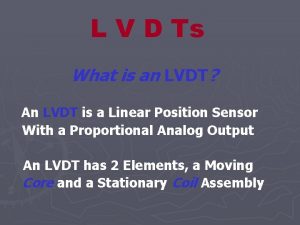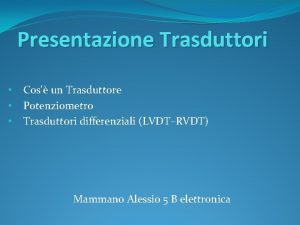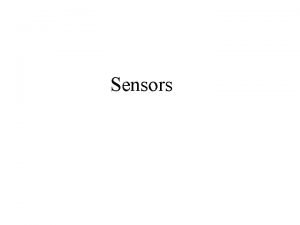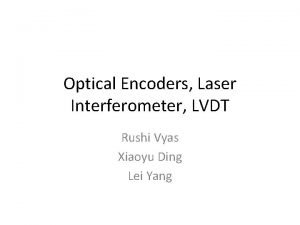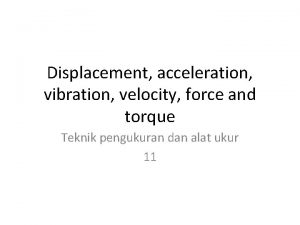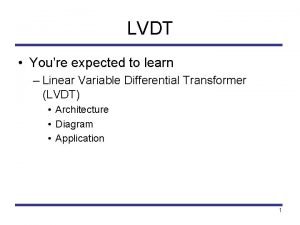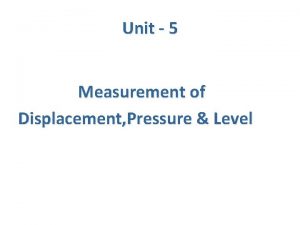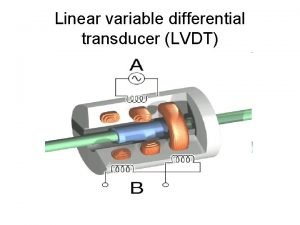L V D Ts What is an LVDT





































- Slides: 37

L V D Ts What is an LVDT? An LVDT is a Linear Position Sensor With a Proportional Analog Output An LVDT has 2 Elements, a Moving Core and a Stationary Coil Assembly

L V D Ts What Do the Letters LVDT Stand For?

L V D Ts Linear Variable Differential Transformer • Transformer: AC Input / AC Output • Differential: Natural Null Point in Middle • Variable: Movable Core, Fixed Coil • Linear: Measures Linear Position

L V D Ts LVDT linear position sensors are readily available that can measure movements as small as a few millionths of an inch up to several inches, but some are capable of measuring positions up to ± 20 inches.

What Is An LVDT? This diagram shows the components of a typical LVDT. The transformer's internal structure consists of a primary winding centered between a pair of identically wound secondary windings, symmetrically spaced about the primary. The coils are wound on a hollow coil form of thermally stable glass reinforced polymer, encapsulated against moisture, wrapped in a high permeability magnetic shield, and then secured in a cylindrical stainless steel housing. This coil assembly is usually the stationary element of the position sensor.

What Is An LVDT? The moving element of the an LVDT is a separate tubular armature of magnetically permeable material called the core, which is free to move axially within the coil's hollow bore, and mechanically coupled to the object whose position is being measured. This bore is typically large enough to provide substantial radial clearance between the core and bore, with no physical contact required between the core and the coil.

What Is An LVDT? In operation, the LVDT's primary winding is energized by alternating current of appropriate amplitude and frequency, known as the primary excitation. The LVDT's electrical output signal is the differential AC voltage between the two secondary windings, which varies with the axial position of the core within the LVDT coil. Usually, this AC output voltage is converted by suitable electronic circuitry to a high level DC voltage or current that is more convenient to use.

How Does An LVDT Work? This figure illustrates what happens when the LVDT's core is in different axial positions. The LVDT's primary winding, P, is energized by an AC source of constant amplitude. The magnetic flux thus developed is coupled by the core to the adjacent secondary windings, S 1 and S 2. If the core is located midway between S 1 and S 2, equal flux is coupled to each secondary so the voltages, E 1 and E 2, induced in each winding are equal. At this midway core position, referred to as the null point, the differential voltage output, (E 1 - E 2), is zero.

How Does An LVDT Work? As shown here, if the core is moved closer to S 1 than to S 2 , more flux is coupled to S 1 and less to S 2, so the induced voltage E 1 is increased while E 2 is decreased, resulting in the differential voltage (E 1 - E 2). Conversely, if the core is moved closer to S 2, more flux is coupled to S 2 and less to S 1, so E 2 is increased as E 1 is decreased, resulting in the differential voltage (E 2 - E 1).

How Does An LVDT Work? This diagram also shows how the magnitude of the differential output voltage, Eout, varies with core position. The value of Eout at maximum core displacement from null depends upon the amplitude of the primary excitation voltage and the sensitivity factor of the particular LVDT, but is typically several Volts AC rms.

How Does An LVDT Work? The phase angle of this AC output voltage, Eout, referenced to the primary excitation voltage, stays constant until the center of the core passes the null point, where the phase angle changes abruptly by 180 degrees, as shown graphically in this diagram.

How Does An LVDT Work? This 180 degree phase shift can be used to determine the direction of the core from the null point by means of appropriate circuitry. As this diagram shows, the polarity of the output signal represents the core's positional relationship to the null point.

How Does An LVDT Work? The diagram shows also that the output of an LVDT is very linear over its specified range of core motion, but that the sensor can be used over an extended range with some reduction in output linearity.

LVDT Support Electronics Although an LVDT is an electrical transformer, it requires AC power of an amplitude and frequency quite different from ordinary power lines to operate properly, typically 3 V AC rms at 3 k. Hz. Supplying this excitation power for an LVDT is one of several functions of the LVDT support electronics, which is also known as LVDT signal conditioning equipment.

LVDT Support Electronics Other functions include converting the LVDT's low level AC voltage output into high level DC signals that are more convenient to use, decoding directional information from the 180 degree output phase shift as an LVDT's core moves through the null point, and providing an electrically adjustable zero output level. This figure is a block diagram of typical LVDT signal conditioning electronics.

LVDT Support Electronics A variety of signal conditioning electronics for LVDTs are available, including chip-level and board-level products for OEM applications as well as modules and complete laboratory instruments for users.

LVDT Support Electronics The support electronics can also be self-contained, as in DC-LVDTs. These easy -to-use position transducers offer practically all of the LVDT's benefits with the simplicity of DC-in, DC-out operation. Of course, LVDTs with integral electronics may not be suitable for some applications, or might not be packaged appropriately for some installations.

Why Use An LVDT? LVDTs have certain significant features and benefits, most of which derive from fundamental physical principles of operation or from materials and techniques used in their construction.

Why Use An LVDT? Friction-Free Operation One of the most important features of an LVDT is its friction-free operation. In normal use, there is not any mechanical contact between the LVDT's core and its coil assembly. There is no rubbing, dragging, or other source of friction. This feature is particularly useful in materials testing, vibration displacement measurements, and high-resolution dimensional gaging systems.

Why Use An LVDT? Infinite Resolution Since an LVDT operates by using electromagnetic coupling principles in a friction-free structure, it can measure infinitesimally small changes in core position. These same factors also give an LVDT its outstanding repeatability. This resolution may be circumscribed by the LVDT signal conditioner’s signal-to-noise ratio and output filtering, and by the output display’s visual resolution.

Why Use An LVDT? Unlimited Mechanical Life Because there is normally no contact between an LVDT's core and coil structure, no parts can rub together or wear out. This means that an LVDT features unlimited mechanical life. This factor is especially important in high-reliability applications such as aircraft, satellites and space vehicles, and nuclear installations. It is also highly desirable in many industrial process control and factory automation systems.

Why Use An LVDT? Over travel Damage Resistant The internal bore of most LVDTs is open at both ends. In the event of unanticipated overtravel, the core is able to pass completely through the sensor’s coil assembly without causing damage. This invulnerability to position input overload makes an LVDT the ideal sensor for applications like extensometers that are attached to tensile test samples in destructive materials testing.

Why Use An LVDT? Single Axis Sensitivity An LVDT responds to motion of the core along the coil's axis, but is generally insensitive to cross-axis motion of the core or to its radial position. Thus, an LVDT can usually function without adverse effect in applications involving misaligned or floating moving members, and in cases where the core doesn't always travel in a precisely straight line.

Why Use An LVDT? Separable Coil And Core Because the only interaction between an LVDT's core and coil is magnetic coupling, the coil assembly can be isolated from the core by inserting a non-magnetic tube between the core and the bore. Thus, a pressurized fluid can be contained within the tube, in which the core is free to move, while the coil assembly remains unpressurized. This feature is often employed in LVDTs used for spool position feedback in hydraulic proportional or servo valves.

Why Use An LVDT? Environmentally Robust The materials and construction techniques used to assemble an LVDT result in a rugged and durable sensor robust to a wide variety of environmental conditions. Bonding of the coil windings is followed by epoxy encapsulation into the case, resulting in superior moisture and humidity resistance, as well as the capability to take substantial shock loads and high vibration levels in all axes. An internal highpermeability magnetic shield minimizes effects of external AC fields on LVDT operation.

Why Use An LVDT? Environmentally Robust Both the case and core are made of corrosion resistant metals, with the case also acting as a supplemental magnetic shield. And for those applications where the sensor must withstand exposure to flammable or corrosive vapors and liquids, or operate in pressurized fluid, the case and coil assembly can be hermetically sealed using a variety of welding processes.

Why Use An LVDT? Environmentally Robust Ordinary LVDTs can operate over a very wide temperature range, but, if required, they can be produced to operate at cryogenic temperatures, or, using special materials, to operate at the elevated temperatures and radiation levels found in many locations in nuclear reactors.

Why Use An LVDT? Null Point Repeatability The location of an LVDT's null point is extremely stable and repeatable, even over its very wide operating temperature range. Thus, LVDTs can perform well as null position sensors in closedloop control systems and high-performance servo balance instruments.

Why Use An LVDT? Fast Dynamic Response The absence of friction during operation permits an LVDT to respond very fast to changes in core position. The dynamic response of an LVDT sensor itself is limited only by the inertial effects of the core's slight mass. Often, the response of an LVDT sensing system is determined by the characteristics of the signal conditioner, usually the roll-off frequency of the low pass filter.

Why Use An LVDT? Absolute Output An LVDT is an absolute output device, as opposed to an incremental output device. This means that in the event of loss of power, the linear position information being sent from the LVDT will not be lost. When the measuring system is restarted, the LVDT's output value will be the same as it was before the power failure occurred.

Why Use An LVDT? CONCLUSION The LVDT represents an optimal solution to many linear measurement problems. An LVDT possesses a number of advantages over other types of position sensors and is cost competitive in most cases.

How to Select an LVDT First Choice to Make: Free Core vs. Guided Core • Free Core Frictionless Operation Possible Mechanically Coupled Core • Guided Core Bearings with Friction, Stiction, etc. Spring- or Air-Loaded Core

Free Core LVDTs • Generally Less Expensive • Many Ranges and Sizes to Choose • More Complicated to Install

Guided Core LVDTs • Usually Simpler to Install • Perceived as More Expensive • More Limited Selection of Ranges and Limited to Short Strokes

How to Select an LVDT Second Choice to Make: AC in / AC out vs. DC in / DC out AC operation: External Support Electronics DC operation: Built-in Support Electronics

AC in / AC out ADVANTAGES • Flexible in Applications- Span and Zero Adjustable, etc. • Many Ranges and Sizes to Choose • More Robust to Environments LIMITATIONS • • Requires External Support Electronics Requires Extra Connections to LVDT Potential Electrical Noise Susceptibility Potential Problems with Long Cables

DC in / DC out ADVANTAGES • Simpler to Hook Up • Precalibrated Operation • Several Input/Output Choices LIMITATIONS • Temperature Environment • No Span or Zero Adjustability • Size Constrained by Internal Electronics


